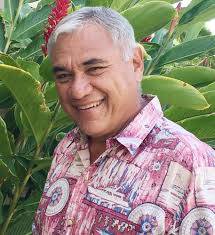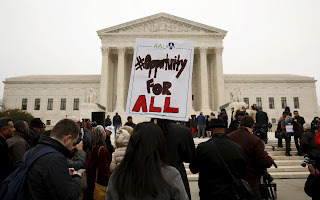The UH President said, "With the adoption of our new strategic plan by the University of Hawaiʻi Board of Regents in November 2022 we have recommitted ourselves to diversity and equity as Foundational Principles. Notwithstanding the new ban on use of race in admissions decisions, UH stands firmly committed to provide higher education opportunities for all, especially those historically underrepresented in our student bodies, as well as to continue to diversify our faculty, staff, and leadership. The families and communities of Hawaiʻi need and deserve no less.
 |
| U.H. Pres. David Lassner said he is beyond disappointed in this week's U.S Supreme Court ruling on affirmative action. U.H. Photo |
"We are now analyzing the Supreme Court ruling and will need to determine if any changes will be required to adhere to the ruling while maintaining our commitments to diversity and equity to meet the educational and workforce needs of Hawaiʻi."
 |
| Congressman Ed Case wins the Leadership Award from the National Marine Sanctuary. Photo from PBN |
 |
| Sol Pili Kaho'ohalahala receives Sanctuary Wavemaker Award. Photo from NOAA |
House Speaker Scott Saiki said it "will deliver direct relief to over 200,000 families, our statewide parks and trails, our climate, and unsheltered individuals in need of mental health assistance."
 |
| Food Excise Tax Credit doubles in the new state budget bills signed by the Governor. Image from HI Tax Fairness |
The state budget that Green also signed, HB300 (Act 164), appropriates $10.7 billion in FY24 and $9.8 billion in FY25 for general funds; $19 billion in FY24 and $18.2 billion in FY25 for Executive Branch departments and agencies for the operating budget. The budget appropriates $2.9 billion in FY24 and $1.3 billion in FY25 for capital improvement projects. Governor Green yesterday provided official notice to lawmakers, finalizing line-item reductions and vetoes.
Dela Cruz said the resources provided within the budget, "coupled with the shared commitment of the legislature and the Governor, will allow for considerable progress to be made in addressing Hawaiʻi's greatest challenges. Millions of dollars have been put forth to tackle homelessness, the housing crisis, mental health, and workforce shortages, to name a few."
Developing affordable housing and infrastructure. "Housing is at a crisis level in the state. Many families leave because they don't have access to affordable housing and some even become homeless. This budget funds a multi-prong approach to build more units, provide subsidies to renters, and to develop much-needed infrastructure to speed up housing development. This budget appropriates $280M to the Hawaiʻi Housing Finance Development Corporation Rental Housing Revolving fund to develop more affordable housing units, $100M to the Dwelling Unit Revolving fund to develop infrastructure and support for affordable housing, over $70M to develop infrastructure, $50M for teacher housing, and $6M for the state rent supplement program to help eligible families pay part of their monthly rent."
 |
| Hawai'i's Child Wellness Incentive Program will pay $50 to state Medicaid recipients for each well child examination. Photo from DOE |
'We must address homelessness in Hawaiʻi, and it will take action, resources, and for us to work together to implement multiple approaches. This budget takes a multi-faceted approach to address homelessness by providing funds for family assessment centers ($3.1M), housing first and rapid re-housing programs ($15M), homeless outreach services ($3.5M), 'ohana zones ($15M) and kauhale ($48M)."
Expanding and improving our healthcare services. "To help recruit and retain the health care workers we need for our residents, we are making big investments ($30M) in the Hawaiʻi State Loan Repayment Program. This program helps pay off educational loans for healthcare workers, including social workers, therapists, and many others who care for patients in Hawaiʻi in areas where there is a healthcare shortage. This budget also makes large investments in our hospital system. We are appropriating $50M to expand the Intensive Care Unit and Medical Surgical Unit at Hilo Medical Center, $2.3M for the Kona community Hospital Pharmacy Expansion, and nearly $30M for Hawaiʻi Health Systems statewide to improve and renovate hospitals, including on our neighbor islands and in our most rural areas.
Preserving our islands for current and future generations. "Hawaiʻi is home to some of the most ecologically diverse areas in the world, and we must act to protect, conserve and manage the unique natural resources that make Hawaiʻi so special.
"This budget appropriates over $100M towards the climate, energy, and environment. Substantial investments are made to protect our natural resources ($20M), restore our state parks ($25M) and ecosystems ($14.8M). We are also funding our Climate Change Carbon Smart Land Management Assistant Pilot Program, which promotes carbon sequestration through forest conservation, farmland preservation, and other regenerative land management practices ($2M). Lastly, we are appropriating $50M to the Hawaiʻi Green infrastructure Authority's Solar Energy Storage Loan Program to increase loan opportunities for ALICE households for the installation of solar panels and battery storage systems ($50M)."
Educating our keiki. "We know that early education for our keiki allows them to develop the skills and tools they need to succeed later in life. That's why this budget provides $38.8M to the Preschool Open Doors Program which will expand assistance to eligible families to pay for preschool for 3- and 4-year-olds, and 36 positions and $3.9M in FY24 and 126 positions and $7.6M in FY25 for preschool teachers, educational specialists, and assistants for the EOEL Public Prekindergarten Program.
"We also need to make sure we support all learners throughout their educational journey. This budget provides 13 additional positions and $1.2M for bilingual and bicultural school home assistants across schools statewide and $5M for classroom supplies to help our schools. In addition, Governor Green's Administration will provide to our schools and university system, additional resources from the discretionary fund that the legislature made available. We know that education is one of the best investments and that we need to support our education system from keiki to college and beyond."
To read comments, add your own, and like this story, see facebook.com/kaucalendar. See latest print edition at kaucalendar.com, in the mail and on stands.











.png)
.jpg)















.pdf-p1.jpg)


-1.jpg)


